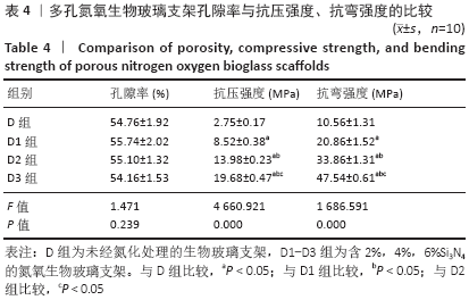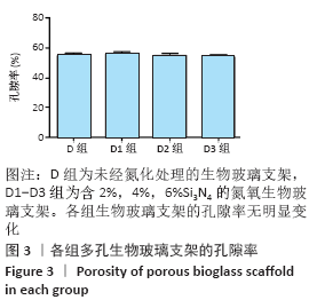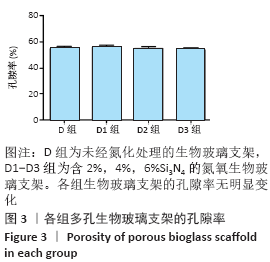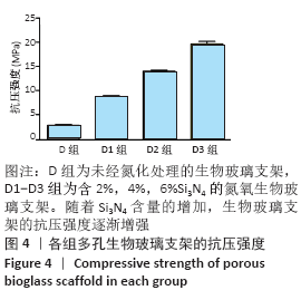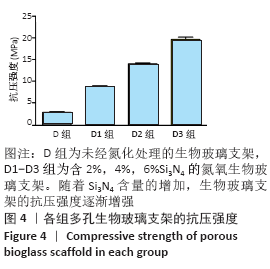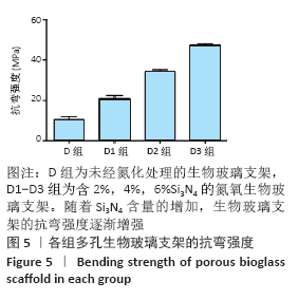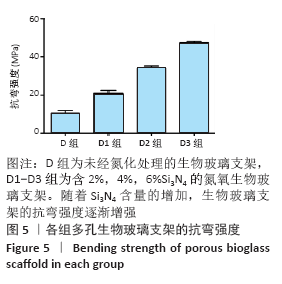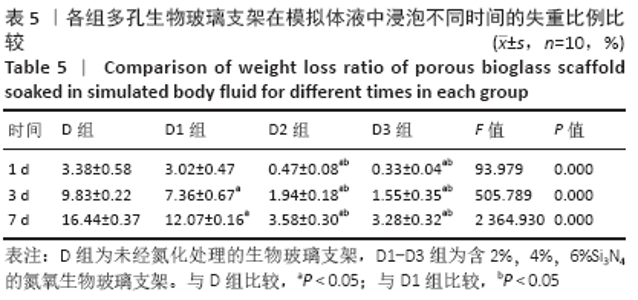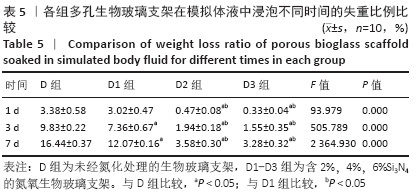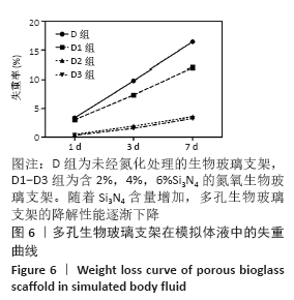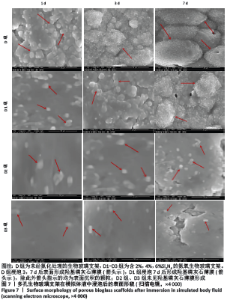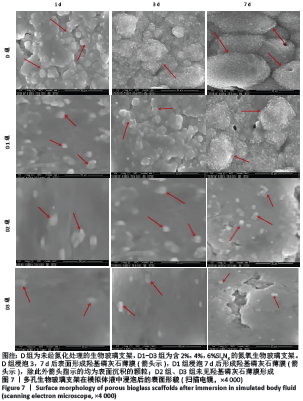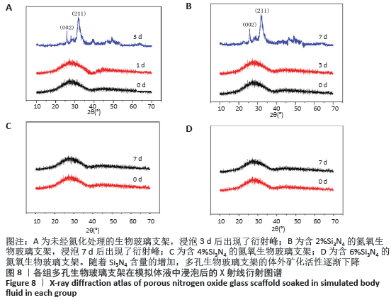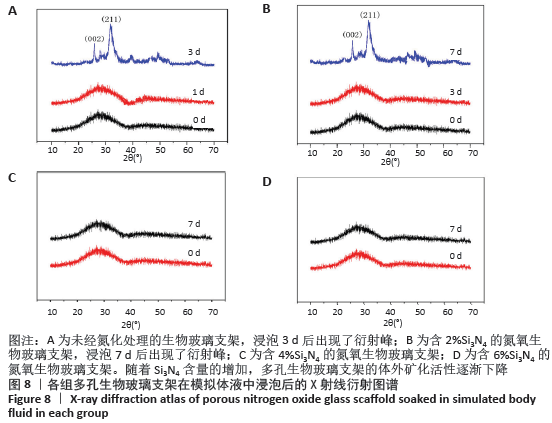[1] 王薇,窦丽鑫,王宏远.生物活性玻璃骨修复支架材料的研究进展[J].口腔颌面修复学杂志,2018,19(6):362-366.
[2] 姚冬旭,曾宇平.多孔氮化硅陶瓷制备及其性能研究进展[J].硅酸盐学报,2019,47(9):1235-1241.
[3] YAO DX, ZENG YP, ZUO KH, et al. The effects of BN addition on the mechanical properties of porous Si3N4/BN ceramics prepared via nitridation of silicon powder. J Am Ceram Soc. 2011;94(3):666-670.
[4] 罗志伟.稀土掺杂氧氮玻璃及其微晶玻璃的制备,表征与性能[D].长沙:中南大学材料科学与工程学院,2013.
[5] 杨高峰,马艳丽.有机泡沫浸渍法Y-Al-Si多孔玻璃制备及性能研究[J].陶瓷,2017(11):28-32.
[6] 中华人民共和国国家标准.多孔陶瓷性能测试方法[S].GB/T,1996.
[7] Testing method for flexural strength (modulus of rupture) of fine ceramics at room Temperature.JIS R1601,2008.
[8] 郭炜煌.生物活性玻璃复合支架的制备及性能研究[D].广州:华南理工大学,2017.
[9] 张亚东.可注射性硼酸盐生物玻璃骨水泥的制备及对骨缺损修复的研究[D].上海:上海交通大学,2015.
[10] 杜瑞琳. Na、Mg、Zn、Ti掺杂58S生物活性玻璃和玻璃陶瓷的制备与性能研究[D].北京:中国科学院,2006.
[11] 吴民行,谢玉芬,翟智皓,等.生物活性玻璃的制备与应用研究进展[J].人工晶体学报,2019,48(1):137-143+148.
[12] WEI XQ, LI QH, LI HC, et al. The use of ZnCl2 activation to prepare low-cost porous carbons coated on glass fibers using mixtures of Novolac, polyethylene glycol and furfural as carbon precursors. New Carbon Mater. 2015;30(6):76-94.
[13] 罗志伟,卢安贤,瞿高,等.Y-Al-Si-O-N-F氧氟氮微晶玻璃的显微结构与力学性能[J].中国有色金属学报,2013,23(4):1099-1106.
[14] FU Q, SAIZ E, RAHA MAN MN, et al. Bioactive glass scaffolds for bone tissue engineering: state of the art and future perspectives. Mater Sci Eng C Mater Biol Appl. 2011;31(7):1245-1256.
[15] 谭玉风.骨移植替代用生物活性玻璃复合材料研究进展[J].齐鲁药事,2012,31(3):171-173.
[16] 小久保正.应用固体化学分野[J].生体材料,2002,20(1):27-28.
[17] 杨立,汪鹏生,张浩,等.生物活性玻璃骨材料力学性能及成骨作用改性的研究进展[J].材料导报,2019,33(S2):553-558.
[18] 胡腾龙,杨柳,颉强.生物活性玻璃的成骨活性及临床应用[J].骨科杂志,2016,7(5):378-380.
[19] JONES JR, EHRENFRIED LM, HENCH LL. Optimising bioactive glass scaffolds for bone tissue engineering. Biomaterials. 2006;27(7): 964-973.
[20] WU ZY, HILL RG, YUE S, et al. Melt-derived bioactive glass scaffolds produced by a gel-cast foaming technique. Acta Biomater. 2011;7(4): 1807-1816.
[21] 姜达君,贾伟涛,张长青.生物玻璃在骨修复中的研究进展[J].中国修复重建外科杂志,2017,31(12):1-5.
[22] BAINO F, NOVAJRA G, VITALE-BROVARONE C. Bioceramics and scaffolds: A winning combination for tissue engineering. Frontiers Bioeng Biotechnol. 2015;3(3):196-202.
[23] HENCH LL, JONES JR. Bioactive glasses:Frontiers and challenges.Frontiers Bioeng Biotechnol. 2015;3:194-205.
[24] ZOCCA A, ELSAYED H, BERNARDO E, et al. 3D-printed silicate porous bioceramics using a non-sacrificial preceramic polymer binder.Biofabrication. 2015;7(2):1-12
[25] FU Q, SAIZ E, TOMSIA AP. Bioinspired Strong and Highly Porous Glass Scaffolds. Adv Funct Mater. 2011;21(6):1058-1063.
[26] 孟雪萍,何茜婵,王芳,等.胶原/生物玻璃/明胶复合材料的研究[J].中国皮革,2017,46(10):8-12.
[27] EL-FIQI A, LEE JH, LEE EJ, et al. Collagen hydrogels incorporated with surface-aminated mesoporous nanobioactive glass: Improvement of physicochemical stability and mechanical properties is effective for hard tissue engineering. Acta Biomater. 2013;9(12):9508-9521.
[28] SIONKOWSKA A, KOZOWSKA J. Urea-induced unfolding of Glossoscolex paulistus hemoglobin, in oxy- and cyanomet- forms: A dissociation model. Int J Biol Macromol. 2013;52:340-348.
[29] 孟永春,陈晓峰,南开辉,等.胶原/生物活性玻璃/壳聚糖增强型复合支架[J].中国组织工程研究,2014,18(21):3367-3373.
[30] 韩笑,曲凤玉.多功能生物活性玻璃的制备及成骨性能研究[D].哈尔滨:哈尔滨师范大学,2015.
[31] LI N, JIE Q, ZHU SM, et al. Preparation and characteriza-tion of macroporous solgel bioglass. Ceram Int. 2005;31(5):641-646. |
